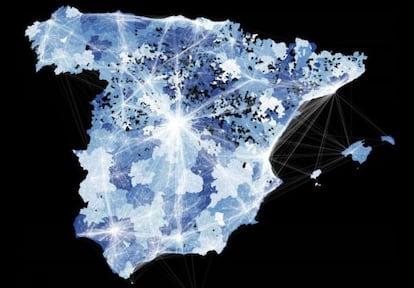What makes Spain tweet?
New nationwide survey finds link between unemployment and use of Twitter social network

Spain’s unemployment blackspots have different tweeting habits to those areas of the country where there are more jobs, according to a new survey on use of the social network carried out by Madrid’s Carlos III University.
“Depending on where you live, you communicate in a certain way, you act differently, and you use a certain number of different words. The local economy is also an influence. It affects the way we communicate, the extent to which we travel or move around, as well as how we use Twitter,” says Esteban Moro, who headed the research team.
Moro and his fellow academics at the publicly funded university say they found a correlation between unemployment levels and the way people used the social network in each of the 340 areas they analyzed.
Previous studies have established a strong connection between a country’s GDP and the extent to which Twitter is used. In each case, the more people tweeted (in proportion to the number of inhabitants), the higher the unemployment level.
But Moro and his team have also discovered that Twitter use varies according to the time of day. Between 8am and 10am, for example, there is a peak in Twitter use in areas with lower unemployment. “People who tweet in the morning belong to sectors that have not been so hard hit by unemployment,” he says.
We were seeking some aspect of social network use that might reflect unemployment levels in each area”
The team then decided to try to establish a link between the education of tweeters and the unemployment levels in their areas. To do this they looked for grammatical errors in tweets. Moro says they found a “significant” link between the two.
They then looked into the mobility of twitterers, tracking the distance users travelled over the course of each day between each message they sent out.
“The idea was to find out if we could establish some aspect of social network use that might reflect unemployment levels in each area,” says Moro, adding that the survey is in no way an attempt to replace official statistics gathering on joblessness. “We hope that this information will complement official figures, given that ours is more up to date. The important thing to remember is that when we think of Twitter we shouldn’t think of some kind of global village, because it doesn’t exist. When you see the map, you see that we’re all different.”
The research was based on 145 million tweets, gathered between November 2012 and June 2013 and sent by some 570,000 individuals.
The survey did not include data from the Canary Islands due both to the one hour time difference, as well as the difficulties in tracking tweets from mainland Spain without including some information from Morocco, which lies between Spain and the Canary Islands.
Tu suscripción se está usando en otro dispositivo
¿Quieres añadir otro usuario a tu suscripción?
Si continúas leyendo en este dispositivo, no se podrá leer en el otro.
FlechaTu suscripción se está usando en otro dispositivo y solo puedes acceder a EL PAÍS desde un dispositivo a la vez.
Si quieres compartir tu cuenta, cambia tu suscripción a la modalidad Premium, así podrás añadir otro usuario. Cada uno accederá con su propia cuenta de email, lo que os permitirá personalizar vuestra experiencia en EL PAÍS.
¿Tienes una suscripción de empresa? Accede aquí para contratar más cuentas.
En el caso de no saber quién está usando tu cuenta, te recomendamos cambiar tu contraseña aquí.
Si decides continuar compartiendo tu cuenta, este mensaje se mostrará en tu dispositivo y en el de la otra persona que está usando tu cuenta de forma indefinida, afectando a tu experiencia de lectura. Puedes consultar aquí los términos y condiciones de la suscripción digital.
Últimas noticias
Pinochet’s victims grapple with José Antonio Kast’s rise in Chile
Reinhard Genzel, Nobel laureate in physics: ‘One-minute videos will never give you the truth’
How Japan is trying to avert ‘digital defeat’
The complicated life of Francesca Albanese: A rising figure in Italy but barred from every bank by Trump’s sanctions
Most viewed
- Pablo Escobar’s hippos: A serious environmental problem, 40 years on
- Why we lost the habit of sleeping in two segments and how that changed our sense of time
- Charles Dubouloz, mountaineering star, retires at 36 with a farewell tour inspired by Walter Bonatti
- Trump’s obsession with putting his name on everything is unprecedented in the United States
- The Florida Keys tourist paradise is besieged by immigration agents: ‘We’ve never seen anything like this’









































